
Essential Steps for Drying Out Your Flooded Home
When disaster strikes and your home is flooded, acting swiftly and effectively is crucial to minimize damage and restore normalcy. One of the key steps in the aftermath of a flood is drying out your home thoroughly. Proper drying not only prevents further structural damage but also mitigates the risk of mold growth, which can pose serious health hazards. In this guide, we’ll walk you through the essential steps for drying out your flooded home effectively.
Steps to Dry Out a Flooded Home
Assess the Damage
Before diving into the drying process, take the time to assess the extent of the damage. Document the affected areas, including walls, floors, and belongings. This evaluation will help you prioritize tasks and determine whether professional assistance is necessary.
Ensure Safety
Safety should always be your top priority when dealing with a flooded home. Turn off the electricity and gas supply to prevent accidents. Wear protective gear such as rubber gloves, boots, and masks to minimize exposure to contaminated water and potential hazards.
Remove Standing Water
The first step in drying out your home is to remove any standing water. Use pumps, wet vacuums, or buckets to extract water from the affected areas. Pay close attention to basements, crawl spaces, and low-lying areas where water may accumulate.
Ventilate the Area
Proper ventilation is essential for speeding up the drying process. Open windows and doors to promote air circulation. Use fans and dehumidifiers to reduce moisture levels in the air. Consider renting industrial-grade equipment for larger spaces or severe flooding situations.
Remove Wet Materials
Once the standing water is removed, focus on removing wet materials such as carpets, insulation, and damaged furniture. These items can harbor moisture and promote mold growth if not properly dried or disposed of. Be sure to wear protective gear and handle contaminated materials with caution.
Clean and Disinfect
After removing wet materials, thoroughly clean and disinfect the affected areas to prevent microbial growth and contamination. Use a solution of bleach and water to sanitize surfaces, walls, and floors. Pay special attention to areas that came into contact with floodwater, including corners and crevices.
Monitor Moisture Levels
Throughout the drying process, monitor moisture levels regularly to ensure that the affected areas are drying effectively. Use moisture meters to measure humidity levels in the air and moisture content in materials such as wood and drywall. Continue drying until moisture levels are within acceptable ranges.
Seek Professional Assistance
If the flooding is severe or if you’re unsure about how to proceed, don’t hesitate to seek professional assistance. A reputable restoration company can provide expertise and specialized equipment to expedite the drying process and minimize further damage to your home.
Contact ECOS for Flooded Home Cleanup
Drying out a flooded home is a challenging task that requires diligence and careful planning. Remember, acting quickly is key to preventing long-term problems such as mold growth and structural damage.
If you’re facing the daunting task of drying out your flooded home, ECOS is here to help. Our team of experienced professionals specializes in flooded home cleanup and restoration, offering prompt and reliable services to homeowners in need. Don’t wait until it’s too late—contact ECOS today for expert assistance in restoring your home to its former glory.
